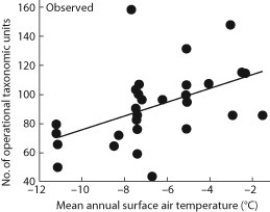Multiple Choice
As fungi play important roles in ecosystem processes as decomposers and symbiont partners, scientists are interested in understanding how global climate change may affect fungal diversity. In 2007-2008, scientists visited the maritime Antarctic, an area of the Southern Hemisphere that is noted to be warming the fastest, to conduct a survey of fungal diversity along a climatic gradient (the most prevalent weather conditions of a region along an incline) . Twenty-nine soil samples were taken along the gradient. Fungal diversity was measured in operational taxonomic units (OTUs) ; one OTU = one cluster, or group, of organisms. Here is a portion of the data collected:
 Source: Newsham, K. K., Hopkins, D. W., Carvalhais, L. C., Fretwell, P. T., Rushton, S. P., O'Donnell, A. G., & Dennis, P. G. (n.d.) . Relationship between soil fungal diversity and temperature in the maritime Antarctic. Nature Climate Change, 6, 182-186.
Source: Newsham, K. K., Hopkins, D. W., Carvalhais, L. C., Fretwell, P. T., Rushton, S. P., O'Donnell, A. G., & Dennis, P. G. (n.d.) . Relationship between soil fungal diversity and temperature in the maritime Antarctic. Nature Climate Change, 6, 182-186.
-In this frigid Antarctic region, there is a thin soil layer that defrosts during the year. However, the rest of the soil in the region, called permafrost, stays frozen. Which of the following characteristics would best help plants to survive in this soil-poor climate?
A) shallow root systems that can grow in the active layer of soil and avoid the permafrost
B) evascular tissue system that allows for faster transport of nutrients
C) flowers with reduced carpels that allow for development of small ovaries
D) thin seed coat layers that will break if water from the permafrost becomes available for use
Correct Answer:

Verified
Correct Answer:
Verified
Q26: In ferns, the _ produces spores by
Q27: The angiosperm plant we see represents the
Q28: Which of the following organisms has a
Q29: Many flower traits are specifically attractive to
Q30: Which of the following represents the male
Q32: Which of the following statements regarding ferns
Q33: In angiosperms, pollen grains develop in the
Q34: Mosses belong to the group of plants
Q35: Heterotrophic eukaryotes that digest their food externally
Q36: The ancestors of land plants were probably